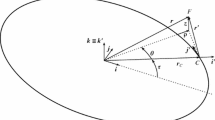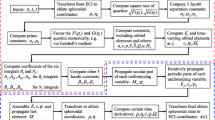Abstract
This paper develops a tensor and its inverse, for the analytical propagation of the position and velocity of a satellite, with respect to another, in an eccentric orbit. The tensor is useful for relative motion analysis where the separation distance between the two satellites is large. The use of nonsingular elements in the formulation ensures uniform validity even when the reference orbit is circular. Furthermore, when coupled with state transition matrices from existing works that account for perturbations due to Earth oblateness effects, its use can very accurately propagate relative states when oblateness effects and second-order nonlinearities from the differential gravitational field are of the same order of magnitude. The effectiveness of the tensor is illustrated with various examples.
Similar content being viewed by others
References
Alfriend, K.T., Schaub, H., Gim, D.-W.: Gravitational perturbations, nonlinearity and circular orbit assumption effects on formation flying control strategies. Advan. Astronaut. Sci. 104, 139–158 (2000), also Paper AAS-00-012 of the AAS Guidance and Control Conference
Alfriend, K.T., Yan, H., Vadali, S.R.: Nonlinear considerations in satellite formation flying. In: 2002 AIAA/AAS Astrodynamics Specialist Conference, AIAA-2002-4741, Monterey, CA (2002)
Battin, R.H.: An Introduction to the Mathematics and Methods of Astrodynamics. AIAA Education Series, American Institute of Aeronautics and Astronautics, Inc., Reston, VA, revised edition (1999)
Bond, V.R.: A new solution for the rendezvous problem. Advan. Astronaut. Sci. 102(2): 1115–1143 (1999), also Paper AAS 99-178 of the AAS/AIAA Space Flight Mechanics Meeting
Broucke, R.A. (2003) Solution of the elliptic rendezvous problem with the time as independent variable. J. Guid. Control Dynam. 26(4): 615–621
Broucke R.A., Cefola P.J. (1972) On the equinoctial orbit elements. Celest. Mech. 5, 303–310
Brouwer D. (1959) Solution of the problem of artificial satellite theory without drag. Astron. J. 64, 378–397
Carter T.E. (1990) New form for the optimal rendezvous equations near a Keplerian orbit. J. Guid. Control Dynam. 13(1): 183–186
Carter T.E. (1998) State transition matrices for terminal rendezvous studies: brief survey and new examples. J. Guid. Control Dynam. 21(1): 148–155
Carter T.E., Humi M. (1987) Fuel-optimal rendezvous near a point in general Keplerian orbit. J. Guid. Control Dynam. 10(6): 567–573
Clohessy W.H., Wiltshire R.S. (1960) Terminal guidance system for satellite rendezvous. J. Aerosp. Sci. 27, 653–658, 674
Euler E.A., Shulman Y. (1967) Second-order solution to the elliptic rendezvous problem. AIAA J. 5(5), 1033–1035
Feagin T., Gottlieb R.G. (1971) Generalization of Lagrange’s implicit function theorem to n-dimensions. Celest. Mech. 3, 227–231
Garrison, J.L., Gardner, T.G., Axelrad, P.: Relative motion in highly elliptical orbits. Advan. Astronaut. Sci. 89(2), 1359–1376 (1995), also Paper AAS 95-194 of the AAS/AIAA Space Flight Mechanics Meeting
Gim D.-W., Alfriend K.T. (2003) State transition matrix of relative motion for the perturbed noncircular reference. J. Guid. Control Dynam. 26(6): 956–971
Gim D.-W., Alfriend K.T. (2005) Satellite relative motion using differential equinoctial elements. Celest. Mech. Dynam. Astron. 92(4): 295–336
Gurfil P. (2005a) Euler parameters as nonsingular orbital elements in near-equatorial orbits. J. Guid. Control Dynam. 28(5): 1079–1083
Gurfil P. (2005b) Relative motion between elliptic orbits: generalized boundedness conditions and optimal formationkeeping. J. Guid. Control Dynam. 28(4): 761–767
Hill G.W. (1878) Researches in the lunar theory. Am. J. Math. 1(1): 5–26
Junkins J.L., Turner J.D. (1986) Optimal Spacecraft Rotational Maneuvers, Studies in Astronautics, vol 3. Elsevier Science Publishers B. V., The Netherlands
Karlgaard C.D., Lutze F.H. (2003) Second-order relative motion equations. J. Guid. Control Dynam. 26(1): 41–49
Kasdin N.J., Gurfil P., Kolemen E. (2005) Canonical modelling of relative spacecraft motion via epicyclic orbital elements. Celest. Mech. Dynam. Astron. 92(4): 337–370
Kaula W.M. (2000) Theory of Satellite Geodesy. Dover Publications, Inc., Mineola, NY
Kechichian J.A. (1998) Motion in general elliptic orbit with respect to a dragging and precessing coordinate frame. J. Astronaut. Sci. 46(1): 25–46
Lawden D.F. (1963) Optimal Trajectories for Space Navigation. Butterworths, London, UK, 2nd edition
Melton R.G. (2000) Time explicit representation of relative motion between elliptical orbits. J. Guid. Control Dynam. 23(4): 604–610
Richardson D.L., Mitchell J.W. (2003) A third-order analytical solution for relative motion with a circular reference orbit. J. Astronaut. Sci. 51(1): 1–12
Schweigart S.A., Sedwick R.J. (2002) High-fidelity linearized J 2 model for satellite formation flight. J. Guid. Control Dynam. 25(6): 1073–1080
Sengupta P., Sharma R., Vadali S.R. (2006) Periodic relative motion near a general Keplerian orbit with nonlinear differential gravity. J. Guid. Control Dynam. 29(5): 1110–1121
Sengupta P., Vadali S.R. (2005) Satellite orbital transfer and formation reconfiguration via an attitude control analogy. J. Guid. Control Dynam. 28(6): 1200–1209
Sengupta P., Vadali S.R., Alfriend K.T. (2004) Modeling and control of satellite formations in high eccentricity orbits. J. Astronaut. Sci. 52(1–2): 149–168
Tschauner J.F.A., Hempel P.R. (1965) Rendezvous zu einemin elliptischer bahn umlaufenden ziel. Astronaut. Acta 11(2): 104–109
Turner J.D. (2003) Automated generation of high-order partial derivate models. AIAA J. 41(8): 1590–1598
Vadali, S.R.: An analytical solution for relative motion of satellites. In: 5th Dynamics and Control of Systems and Structures in Space Conference, Cranfield University, Cranfield, UK (2002)
Vadali S.R., Vaddi S.S., Alfriend K.T. (2002) An intelligent control concept for formation flying satellites. Int. J. Robust Nonlinear Contr. 12, 97–115
Vaddi S.S., Vadali S.R., Alfriend K.T. (2003) Formation flying: accommodating nonlinearity and eccentricity perturbations. J. Guid. Control Dynam. 26(2): 214–223
Wolfsberger W., Weiß J., Rangnitt D. (1983) Strategies and schemes for rendezvous on geostationary transfer orbit. Acta Astronaut. 10(8): 527–538
Yamanaka K., Ankersen F. (2002) New state transition matrix for relative motion on an arbitrary elliptical orbit. J. Guid. Control Dynam. 25(1): 60–66
Yan, H.: Dynamics and Real-Time Optimal Control of Aerospace Systems. Dissertation, Texas A&M University, College Station, TX (2006)
Yan, H., Sengupta, P., Vadali, S.R., Alfriend, K.T.: Development of a state transition matrix for relative motion using the unit sphere approach. Advan. Astronaut. Sci. 119(1), 935–946 (2004), also Paper AAS 04-163 of the AAS/AIAA Space Flight Mechanics Meeting
Author information
Authors and Affiliations
Corresponding author
Rights and permissions
About this article
Cite this article
Sengupta, P., Vadali, S.R. & Alfriend, K.T. Second-order state transition for relative motion near perturbed, elliptic orbits. Celestial Mech Dyn Astr 97, 101–129 (2007). https://doi.org/10.1007/s10569-006-9054-5
Received:
Accepted:
Published:
Issue Date:
DOI: https://doi.org/10.1007/s10569-006-9054-5




